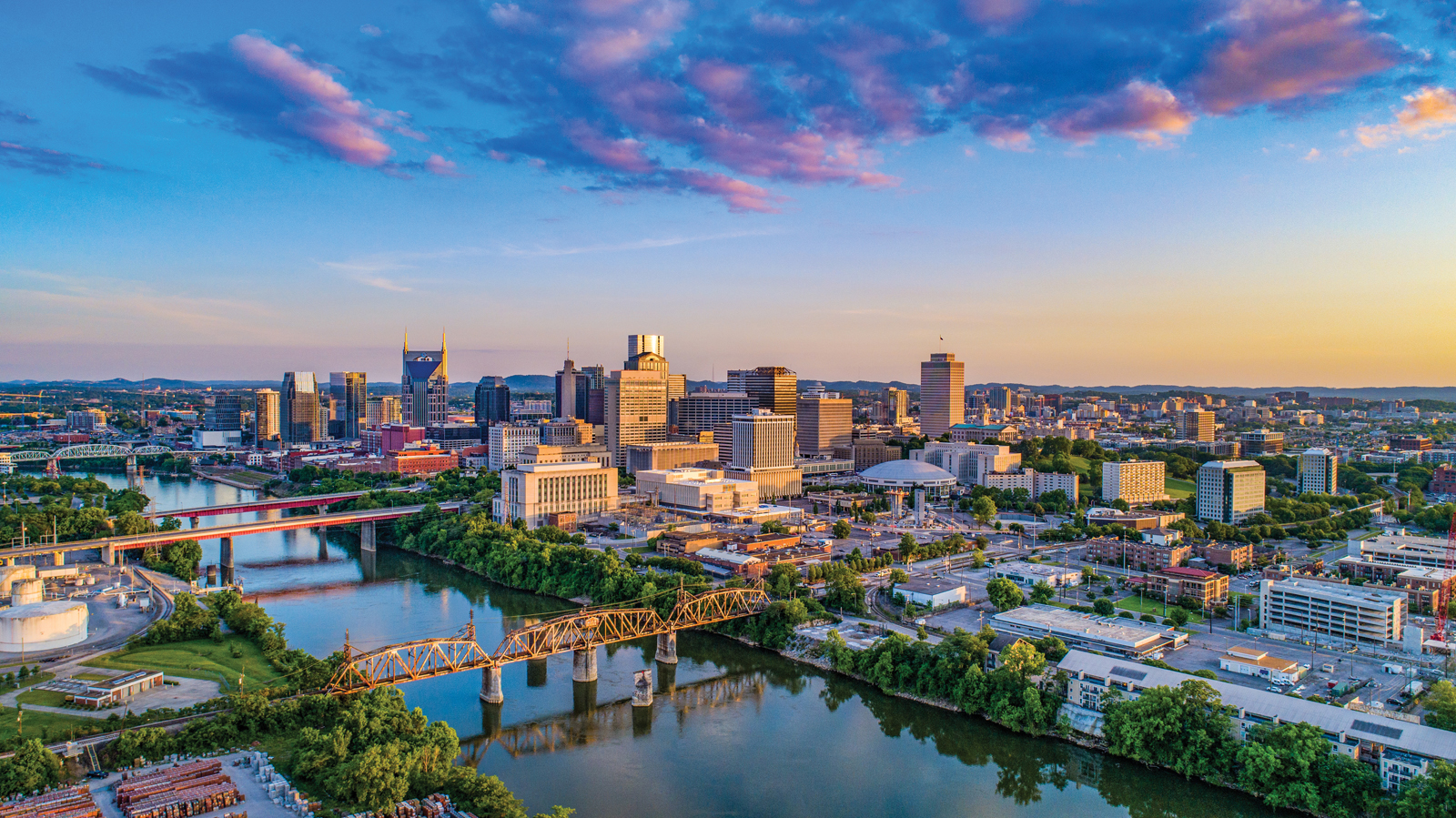
BY PAULA MIDDLEBROOKS
Nashville has been known as Music City and the Country Music Capital of the World for decades. A more recent designation has Nashville ranked among the top 25 most populous cities in the USA, with a population increase of more than 10 percent since 2010. 1 With rapid growth, infill is occurring at a swift pace, and infill happens on brownfields.
Increasingly, brownfields redevelopment has become an important part of economic development and community revitalization strategies across the country. Brownfields are properties which may contain real or perceived environmental contamination that hinder their redevelopment or re-use. Many brownfields are under-utilized or abandoned facilities with a history of manufacturing. Other common types of brownfields include old mills and factories, junkyards, former dry cleaners, railyards, mine-scarred lands, and abandoned gas stations.
Brownfields exist in towns of all sizes. While not all municipalities and rural areas have experienced the growth that Nashville has, the potential for brownfields redevelopment is nonetheless abundant everywhere. These idle properties can be a burden on neighbors and threaten public health, local economies, and communities. The cleanup and re-use of these properties can have significant social and community benefits, in addition to economic and environmental benefits, as illustrated by the following case studies.
Case Study: From Bridges to Climbing Walls
Located along the east bank of the Cumberland River, adjacent to downtown Nashville, the Nashville Bridge Company was originally founded as a bridge builder in the 1890s. In 1915, the company converted to shipbuilding, and by the 1960s, it was said to be the world’s largest builder of inland barges. The facility closed in 1996, when it was decided a new stadium for the Tennessee Titans would be built on a portion of the property. However, the closure left the riverfront portion of the property sitting vacant.
Under the New Riverfront Park Plan, it was determined that new public parks, open space, and recreational amenities would be added along the downtown riverfront. 2 In 2008, due to the historical uses of the property, environmental site assessments were conducted utilizing Environmental Protection Agency (EPA) Region 4 Targeted Brownfields Assessment assistance. Additional assessment and technical oversight by the Tennessee Department of Environment and Conservation, Division of Remediation (TDEC-DoR) were completed using EPA 128(a) brownfields funds. The assessments identified several areas impacted by polycyclic aromatic hydrocarbons (PAHs), lead, and arsenic that required cleanup. The TDEC-DoR and the Metro Parks and Recreation Department worked cooperatively to develop and implement plans that incorporated a combination of soil removals, engineered caps, and institutional controls to address environmental concerns and provide for safe reuse of the property.
Today, the Cumberland Play Park is an innovative play space for children and families located on the east bank of the Cumberland River in downtown Nashville. It is a portion of an overall revitalization project on approximately three miles of land on both the east and west bank of the river. The park includes a local stone climbing wall, sand play areas, garden mazes, outdoor seating, meandering paths, and other interactive play areas.
Adaptive reuse, water harvesting for irrigation, and improved biodiversity were also included in this brownfield redevelopment project. Each year, one million gallons of stormwater are captured and reused for irrigation. Over 1.6 acres of meadow and riparian grasses were restored. There is also an outdoor amphitheater that can accommodate 1,200 people. The historic Bridge Building, originally built in 1908 for the Nashville Bridge Company, has been restored and is now home to a MetroParks office and event space, and has earned the highest rating for sustainable buildings (LEED-Platinum) by the U.S. Green Building Council.
Case Study: From Landfill to Solar Power
A 37-acre tract of land, located approximately seven miles northeast of downtown Nashville, was formerly known as the Due West Landfill. After serving as a municipal landfill from approximately 1958 to 1973, and covered with rock excavated from the construction of Interstate 65, the land sat vacant. In 1997, a portion of the property entered into TDEC’s Voluntary Cleanup, Oversight, and Assistance Program (VOAP). The state approved closure of the site with an engineered cover on the landfill in 2002. The property was subsequently monitored for the release of methane, iron, and manganese. Land use restrictions were also placed on the property to limit its use at the time.
But in 2016, the city of Nashville showed interest in transforming the vacant land, adjacent to a major medical center, into a property designed to showcase its environmental and community benefits. The TDEC-DoR issued a “no further action” letter for the site to address soil gas and leachate. In the spring of 2018, the Nashville Electric Service (NES) broke ground for the Music City Solar Array (MCSA), located on a portion of the former landfill, transforming 25 acres of the site into Nashville’s first community solar park. In August 2018, MCSA began operating, producing renewable energy back to the power grid. The solar park gives NES customers access to sustainable, maintenance-free solar energy. The two-megawatt facility uses over 17,000 solar panels, with each panel generating an estimated 14 kilowatt hours per month of green energy for Nashville’s electric grid.
Case Study: From Clay Targets to Mixed Use
A 38-acre property composed of several parcels, adjacent to downtown Nashville and Interstate 65/Interstate 40, is currently being transformed in phases into a large mixed-use development. Historical use of the property was residential in the 1800s, and gradually became commercial during the 1900s. The property was used for a variety of commercial and industrial purposes, including a car dealership with a bakery, railroad exchange yard, cold storage, bookstore, beer distributor, aluminum can collection center, restaurant, woodworking shop, clay target launcher manufacturer, coal storage, and an auto body shop, among other uses. This property is situated between an active rail line and the two interstates along Dr. Martin Luther King Blvd., adjacent to the Gulch neighborhood.
Between 2005 and 2012, environmental site assessments were conducted at the property, and environmental issues were identified. Contamination was primarily confined to the soils and consisted mainly of petroleum and automotive-related products and wastes, as well as PAHs. Some of the contaminants identified were the result of buried coal and coal wastes related to the original railroad and industrial activities in the vicinity of the site used as backfill when parcel grades were raised during the burial of the local sewers dating back to the mid-1800s. To address these issues, the property was entered into the VOAP in phases, starting in 2013.
Subsequent remedial activities at the site included the removal and proper disposal of 369 tons of contaminated soils, 20 in-ground hydraulic lifts, and one 560-gallon underground storage tank from just one of the parcels on this large site. Groundwater sampling was also done prior to construction on the property, and an oil/water separator was removed and confirmatory sampling completed to confirm a clean closure.
A multi-disciplinary team including developers, engineers, environmental professionals, and the TDEC-DoR worked together to make this cleanup and redevelopment a success through the VOAP. Numerous brownfields voluntary agreements, land use restrictions, and soil management plans were put in place to ensure safe use of the property.
The mixed-use finished project, called Capitol View, will span 38 acres and include buildings with a collective 1.1 million square feet of Class A office space, 130,000 square feet of retail and restaurant space, a 169-room hotel, grocery store, urgent-care clinic, a high-end apartment building, and a 2.5-acre park complete with free parking. The Urban Activity Park will include a dog park, playground, yoga lawn, and sand volleyball courts. The park is also a trail head for the Nashville Greenway, connecting to 190 miles of trails through Davidson County, and will be donated to Metro Nashville Government upon completion.
Addressing Brownfields
Timing is often a critical component to brownfields redevelopment. Contamination, or potential contamination, is typically identified during pre-transaction environmental due diligence screening or “all appropriate inquires.” This is accomplished by performing a Phase I Environmental Site Assessment (ESA). A Phase I ESA is completed to research the current and historical uses of a property. If the findings of the Phase I ESA show additional studies are needed, a Phase II ESA may be needed to collect samples for laboratory analysis. Typically, a Phase II ESA involves sampling of groundwater, surface water, soil, and/or soil gas. Understanding the scope of environmental impacts of a property, prior to a property transaction and development of site plans, can save money and time in the property transaction and development of the site.
The TDEC works with a variety of sectors on brownfields redevelopments, including municipalities, land owners, redevelopment agencies, consulting firms, attorneys, nonprofits, and other entities. State involvement early on in brownfields projects is key. The VOAP provides liability protection to purchasers of property who address environmental impacts. The VOAP has had over 500 properties enter the program across Tennessee since its inception in 2001. The state also works with EPA 104(k) brownfields grant applicants to provide support during the application process and to provide technical oversight on active grants. There has been over $5 million awarded to Tennessee recipients since 2010 for the assessment and cleanup of brownfields, and the state has overseen the technical components at no cost to the communities. Both of these programs serve the entire state, beyond Nashville.
Recently, Tennessee passed a state law expanding tax incentives for counties in Tennessee.3 The 2019 law amended a previous law to expand benefits to small and mid-sized counties with greater flexibility for the size of brownfields being redeveloped. The law also expands redevelopment zones to include qualified Opportunity Zones and expands qualified costs to include investigation, remediation, or mitigation of a brownfield project.
When entities work toward the shared goal of safe reuse of environmentally impacted properties, brownfields redevelopment can flourish. Proactively identifying these properties—and seeing them as an asset and part of a community’s history instead of simply eyesores—is critical to growth at any pace.

ENDNOTES AND RESOURCES
1 https://www.tennessean.com/story/news/2019/05/24/nashville-population-growth-percent-us-census-2018-top-25-rank/1214610001/
2 https://www.civicdesigncenter.org/pdfs/NashvilleRiverfrontReport.pdf
3 http://wapp.capitol.tn.gov/apps/BillInfo/default.aspx?BillNumber=SB0355&GA=111
New, Reduced Membership Dues
A new, reduced dues rate is available for CAOs/ACAOs, along with additional discounts for those in smaller communities, has been implemented. Learn more and be sure to join or renew today!
